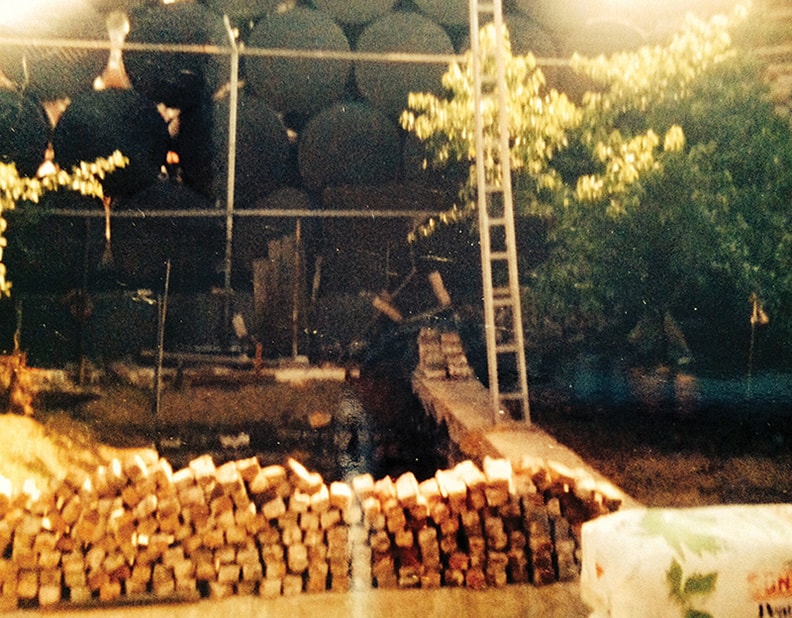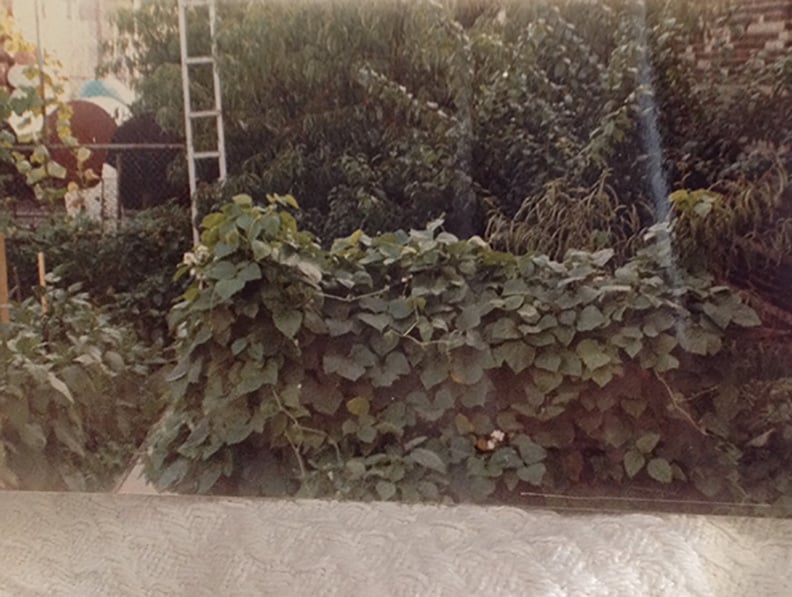It was barely a few days before Christmas when my son, John reminded me that we had not yet bought fish for our traditional Christmas Eve Fish Fest. I admit, I was dragging my foot about the whole holiday in general since the only surviving patriarch in our family was hospital bound with a stroke – and then, a serious fall. I spent more Christmases than I had ever wished in my life with grandparents passing on before the holidays that I had slipped into a melancholy mood.
John cajoled me into taking heart and forging on with the holidays as usual. He assured me that we could modify and adapt to whatever the circumstances called for. In the spirit of Christmas, he offered to accompany me to lighten the mood and make an afternoon of it together.

Before I knew it, we were Brooklyn bound talking up a storm about Christmases past, when I realized none of my children had ever taken the shopping excursion with me to buy the fish. When they were small, the fish came duly delivered, courtesy of my father. When they were teenagers and young adults – after my father had passed – they were in school or working. The task belonged solely to me. A task that involved re-inventing the process of where to get the best fish for my buck…that my father would have approved.
It took several years, but I finally managed to tweak the hunt down to a satisfactory outcome. My purchases, with little help from those whom I would have expected it, were made in several markets and at various times to coordinate the timing and preparation of the days leading up to the Christmas Eve finale.
However, on this day, there was only time to get everything in one day. These were the thoughts that were running through my head when my son interrupted them. “Are we going to get everything at the Fulton Fish Market?” he asked. Logical question since, yes, that is exactly where my father used to get most of his fish.
“No.” I replied. “They moved to the Bronx many years ago, and, truthfully, I never thought to trek that far a distance, especially before the holidays, when it’s a madhouse.”
I explained to him the routine I had developed in Brooklyn – mostly in and around the neighborhood. “You’ll see,” I told him. “We’ll do good.”
Like myself, John maintained an interest in ancestral connections and sentiment to his grandparents. Following in their footsteps – or honoring what they valued most – is of particular importance to him. His question prompted me to recall those Fulton Fish Market excursions my siblings and I took as little kids with his grandfather back in the sixties.
“Oh my God, it was always soooo cold,” I told him. “He woke us in the middle of the night and we had to take a bus and train to get to Manhattan. When we got there, the fish mongers were yelling at the tops of their lungs, trying to lure customers to their tables. There were fires in steel barrels everywhere to keep us from freezing to death.” John laughed.
“And, of course, Grandpa had to double check everything they were selling. We just wanted to hurry up and get back home so we could get back into our beds in time for the radiators to start clanging and hissing so we could warm up. Forget it! That never happened. Inevitably, Grandpa would always come across some fishmonger trying to sell him old fish, but passing it off as fresh – the ultimate insult! ‘Jesus Christ,’ he’d tell the guy, ‘go sell it to your mother, then, not me.’ That usually started an argument and we wanted to crawl under a hole somewhere.” We laughed hard together. I, vividly remembering that scenario; he, envisioning it – accent, hand gestures and all!
“Can we go to the Bronx next year?” John asked, as his laughter settled a bit. “I’d like to really see what that was like. I mean, to see the open market and what Grandpa was best at doing.”
“Well, you could see some of that here, in Red Hook and Carroll Gardens, Cobble Hill, all of it. He shopped for fish here, too.”
“Yeah, but it’s all different now.”
I thought about that. “Yeah, that’s true,” I whispered to myself. I wondered how long I could hang onto to Red Hook as I knew it in its prime for my generation. How many more changes needed to take place before I could say it’s over. It’s been over. Throughout the years, my kids looked at storefronts I had pointed out to them that once were. Buildings that are no longer standing that held many memories. Buildings that have replaced landmarks. Churches that once served congregations, not tenants. There’s no going back, I thought sadly.
We arrived at our main fish “market” on Douglas Street, a huge wholesale garage that sells to the public during Christmas. It was uneventful for my son, I could see, as he roamed from one freezer chest to another as we selected boxes of frozen lobsters, calamari and octopus. He was hankering for a real fish experience.
Instead, we headed to Whole Foods – a last minute decision. I couldn’t think of a better place, actually, that would have the remaining scallops and shrimp I needed that would be of decent quality. And I could pick up all the sides and other ingredients I needed there as well.
It was my second time at Whole Foods in Gowanus since its opening, and Christmas seemed to be the perfect time to be there. Purveyors of all kinds were in full force with tastings. A couple of them with samples of oysters from Connecticut and the North Fork was a huge score for us. We didn’t mean to, but we found ourselves slurping down more than our share – they were that good! So, we bought a dozen to make up for their loss. Hey, it was Christmas. “Grandpa would have enjoyed these,” I told my son, “but he may have thought the price was high. Yet if you asked me, I’d say he would’ve bought five dozen.”
We continued our little roam-about, sampling pizza from Third Avenue and yogurt in Park Slope, both made from scratch with locally grown fresh ingredients.
“Really, when you think about it, John, this concept of the neighborhood hasn’t really changed.” I told him that when we were kids growing up there, our food stores weren’t much different in their preference for fresh, locally grown produce and artisinal products. We just never called them “artisinal.”
I pointed out the cranberries gently bobbing in a box of cool water, simulating their water-filled bogs when harvested, waiting to be picked. And how a lot of the produce was packed in netting as opposed to plastic bags; we had brown bags or paper wrappings for our foods.
Our sustainability efforts were never planned, nor were they an ideology, we just lived it. Having our own gardens, cultivating and composting our back yards fed us nutritiously and saved our earth without ever thinking about it. It’s more of a movement now – for obvious reasons – with short and long term goals that have a huge impact on our future. Those organic practices and vibes are still the pulse in the area. “In a way, the past still resonates here.” I said, reassuring myself as much as John.
Our afternoon shopping came to an end as we decided to have dinner together upstairs at the Roof Café. There were hipsters frolicking with their kids in the play area. A roof-top greenhouse with rows of healthy looking produce sat adjacent to the café. The table tops in the restaurant looked like recycled wood planks from long ago. We passed a sign that explained that the outside construction of the Third and 3rd Whole Foods was built with bricks from the old Westinghouse Building in New Jersey.
I reminded John that when we were in Italy, we had learned that many ruins had been dismantled to re-use the materials for newer buildings. It had to stop, though, lest they removed history in its entirety. (i.e. the Coliseum).
I told him the story of our own garden in Red Hook. “Being the farmer that he was, Grandpa dug out most of the back yard to make a huge garden bed. ” I said. “As he dug, he came across the foundation of a building. There were several houses we knew of in the area that were built one behind the other. You would walk through the hallway of the first building to the back yard, to get to the second building behind it. That probably explained why public records show two house numbers for one parcel for some addresses. It was in our case. Anyway, he dug up all those bricks and left it in the back yard, in case, as he said, ‘we need it for something else.’ Well, John, the two long strips of brick that is on our driveway at home are none other than those bricks from Luquer Street. We found that ‘something else’. Waste not, want not. We went ‘green’ and it saved a lot of money!”

Our food came. Burgers made from grass-fed cows, brioche rolls and fresh vegetables on the side. We were given old mason jars for our drinks, fittingly characteristic of the old neighborhood, and, of all things, in place of napkins, we were given the cotton, restaurant-style dish towels that we used as kids. My son recognized them right away as the towels my father used to wash and sanitize from Sam’s Restaurant on Hamilton Avenue after Sam tossed them out for garbage!
“He was ahead of his time, really,” I emphasized to John, thinking to myself how he was one of the lone thinkers of his time. An earth friendly, inherent recycling enthusiast, and an early seedling of a foodie, with much of the same entrepreneurial concepts that could be seen all around Red Hook and Williamsburg.
Smorgasburg, slow food, wine making, city farming, canning, foraging mushrooms – all examples of the commonality he had with the current day hipster movement. “Everywhere I turn,” I told John, “I see remnants of Grandpa’s ideas for food-based businesses here.”
We went home that evening, uplifted and expecting to trim our tree. My friend from Red Hook called me, just minutes after we had arrived. “Did you hear about the two cops that got shot in Bed-Stuy?” she asked. I had not.
In the midst of enjoying an afternoon out with my son in the neighborhood – something I would not have been able to do had Red Hook and the surrounding areas not been gentrified, if gangs were still running amuck, or subcultures inciting riots, and drug addicts and dealers making the streets a challenge to shop, go to school or work – I was unaware that two officers were killed execution style.
I sickened at the thought of how each of the actions during the previous few weeks were causing reactions, in much the same pattern it did in the 60s and 70s. Images of liberation parties and their offshoots were coming back to life in my head. It was those riots that left the deepest groove in our memories as Red Hookers more than anything. It crippled our freedom and reinforced our belief that we were not safe, not wanted and not prepared for resolution, in a peaceful way.
It comes in cycles, perhaps, and my worst fear at that very moment was that Red Hook as we know it now, could be at the tip of becoming what it was. All over again.









2 Comments
Very interesting article. Thanks for posting.
Loved reading this story! It brought be back to the good old days.